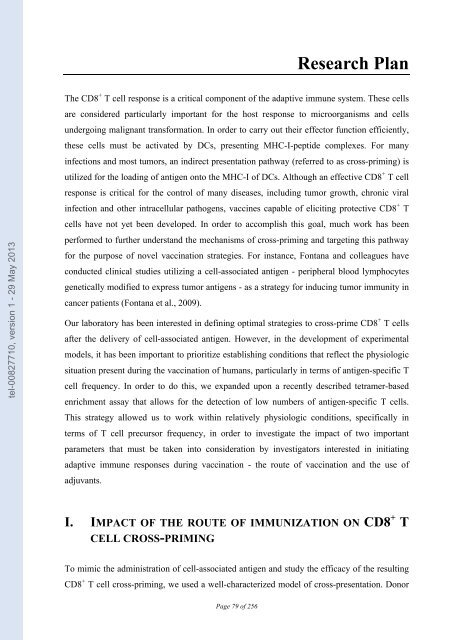Voie d'immunisation et séquence d'administration de l ... - TEL
Voie d'immunisation et séquence d'administration de l ... - TEL
Voie d'immunisation et séquence d'administration de l ... - TEL
You also want an ePaper? Increase the reach of your titles
YUMPU automatically turns print PDFs into web optimized ePapers that Google loves.
tel-00827710, version 1 - 29 May 2013<br />
Page 79 of 256<br />
Research Plan<br />
The CD8 + T cell response is a critical component of the adaptive immune system. These cells<br />
are consi<strong>de</strong>red particularly important for the host response to microorganisms and cells<br />
un<strong>de</strong>rgoing malignant transformation. In or<strong>de</strong>r to carry out their effector function efficiently,<br />
these cells must be activated by DCs, presenting MHC-I-pepti<strong>de</strong> complexes. For many<br />
infections and most tumors, an indirect presentation pathway (referred to as cross-priming) is<br />
utilized for the loading of antigen onto the MHC-I of DCs. Although an effective CD8 + T cell<br />
response is critical for the control of many diseases, including tumor growth, chronic viral<br />
infection and other intracellular pathogens, vaccines capable of eliciting protective CD8 + T<br />
cells have not y<strong>et</strong> been <strong>de</strong>veloped. In or<strong>de</strong>r to accomplish this goal, much work has been<br />
performed to further un<strong>de</strong>rstand the mechanisms of cross-priming and targ<strong>et</strong>ing this pathway<br />
for the purpose of novel vaccination strategies. For instance, Fontana and colleagues have<br />
conducted clinical studies utilizing a cell-associated antigen - peripheral blood lymphocytes<br />
gen<strong>et</strong>ically modified to express tumor antigens - as a strategy for inducing tumor immunity in<br />
cancer patients (Fontana <strong>et</strong> al., 2009).<br />
Our laboratory has been interested in <strong>de</strong>fining optimal strategies to cross-prime CD8 + T cells<br />
after the <strong>de</strong>livery of cell-associated antigen. However, in the <strong>de</strong>velopment of experimental<br />
mo<strong>de</strong>ls, it has been important to prioritize establishing conditions that reflect the physiologic<br />
situation present during the vaccination of humans, particularly in terms of antigen-specific T<br />
cell frequency. In or<strong>de</strong>r to do this, we expan<strong>de</strong>d upon a recently <strong>de</strong>scribed t<strong>et</strong>ramer-based<br />
enrichment assay that allows for the d<strong>et</strong>ection of low numbers of antigen-specific T cells.<br />
This strategy allowed us to work within relatively physiologic conditions, specifically in<br />
terms of T cell precursor frequency, in or<strong>de</strong>r to investigate the impact of two important<br />
param<strong>et</strong>ers that must be taken into consi<strong>de</strong>ration by investigators interested in initiating<br />
adaptive immune responses during vaccination - the route of vaccination and the use of<br />
adjuvants.<br />
I. IMPACT OF THE ROUTE OF IMMUNIZATION ON CD8 + T<br />
CELL CROSS-PRIMING<br />
To mimic the administration of cell-associated antigen and study the efficacy of the resulting<br />
CD8 + T cell cross-priming, we used a well-characterized mo<strong>de</strong>l of cross-presentation. Donor

















